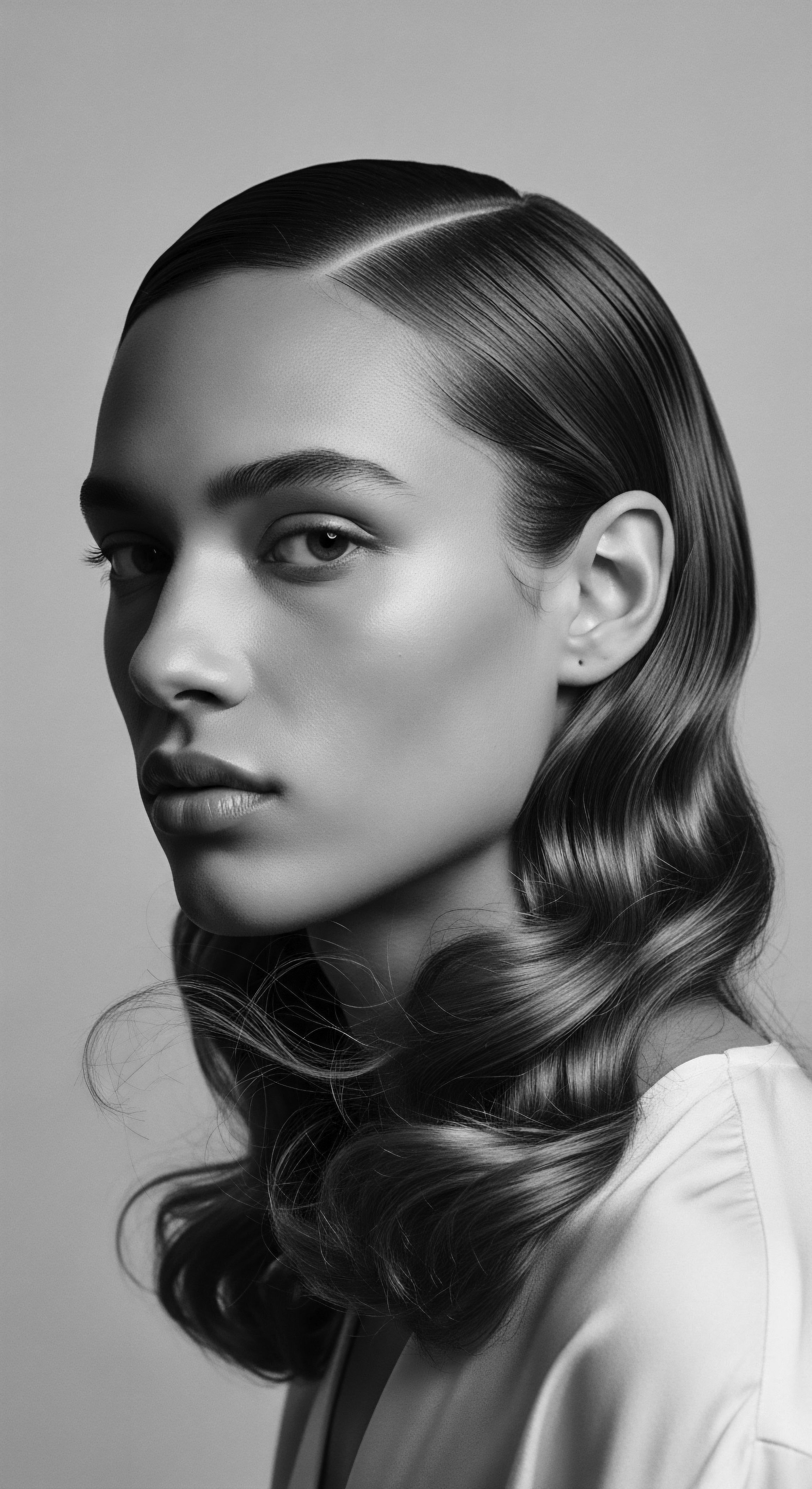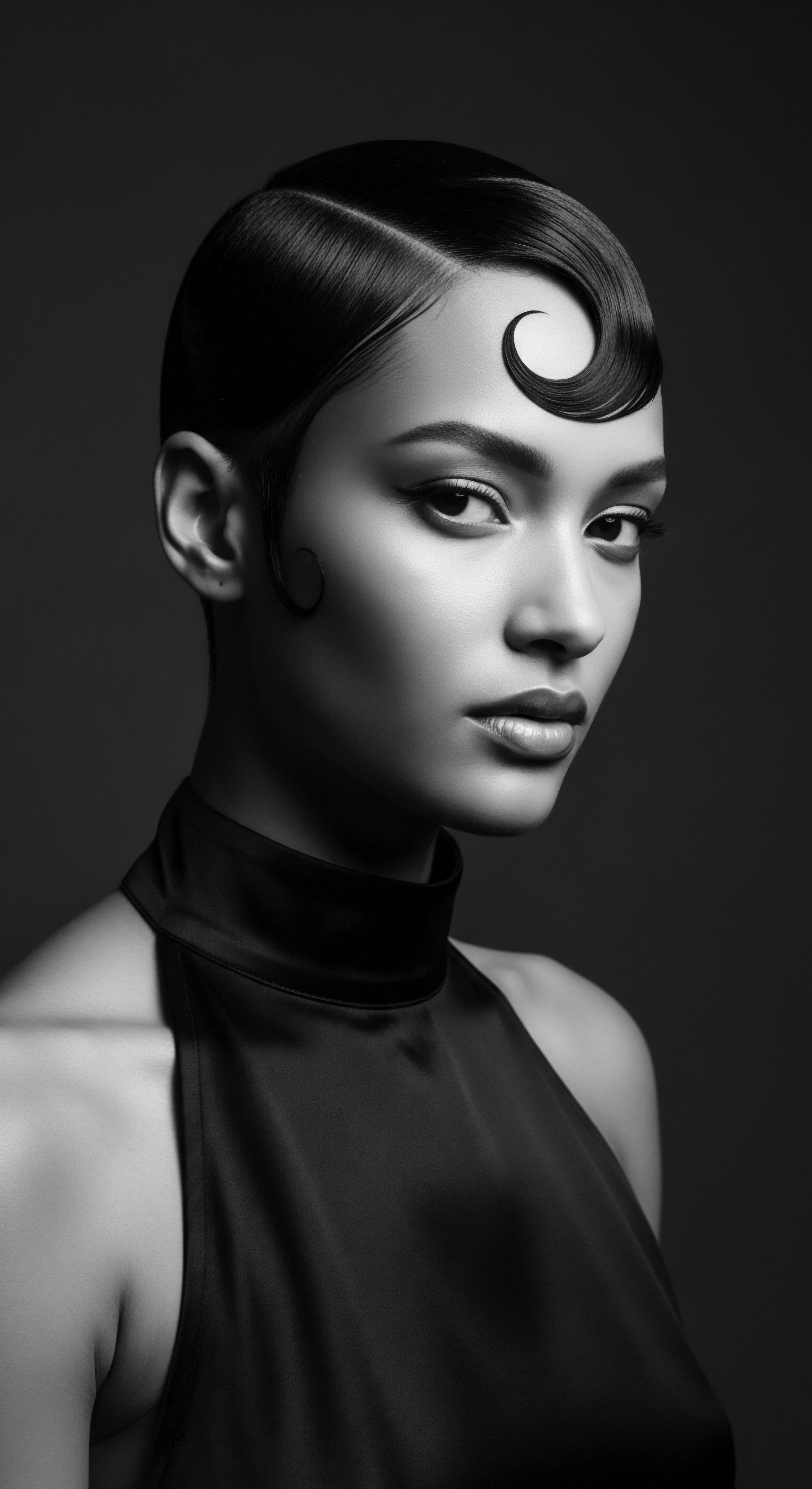
Fundamentals
The strands that crown our heads, particularly those with the unique, coiled, and spiraled architecture often seen in textured hair, carry a profound legacy. Understanding their very being, their vulnerabilities, and their enduring strength begins with a look at what constitutes their primary substance ❉ protein. At its core, protein degradation within the context of hair represents the breakdown of these essential building blocks, the structural components that grant hair its resilience, its spring, and its very shape.
When we speak of a strand’s physical being, we are often referring to keratin, a fibrous protein. This remarkable substance forms the vast majority of the hair shaft, organized into complex hierarchical structures, from the outermost cuticle scales to the inner cortex, and sometimes a central medulla.
The meaning of protein degradation is a process by which these keratin proteins, once robust and intricately woven, begin to unravel, to diminish in their integrity. Imagine a finely spun ancestral basket; over time, the natural fibers may fray, weaken, or even break, losing their original form and utility. Such is the way of hair proteins. This weakening can arise from a myriad of influences, both from within and from the surrounding world.
Sunlight, a constant companion in our lives, delivers ultraviolet radiation that can lead to protein degradation, diminishing the hair’s inherent strength and vibrancy. Mechanical friction, the gentle touch of a comb or the simple motion of daily life, also contributes to the gradual wear of these vital proteins, causing the outermost protective layers to lift or chip away. Water, a life-giving element, can also be a silent agent in this process, especially when hair is repeatedly saturated and dried, leading to a subtle but steady decline in protein cohesion.
Hair’s resilience, its very essence, rests upon the integrity of its keratin proteins, making their preservation a timeless concern.
For generations, long before the advent of modern chemistry, ancestral communities instinctively recognized the vulnerability of hair to these elemental forces. Their practices, honed by observation and inherited wisdom, served as natural bulwarks against such degradation. The gentle application of plant-based oils, passed down through oral traditions, might have shielded strands from the harsh intensity of the sun’s rays, acting as a natural emollient that reduced friction during styling. Protective styles, like intricate braids and coiled formations, were not solely expressions of identity or artistry; they physically safeguarded the hair shaft from continuous exposure to environmental stressors, minimizing mechanical strain.
These traditions, born of necessity and deep connection to the natural world, offered an intuitive understanding of protein preservation, without needing scientific labels. The wisdom lay in observation, in the tender touch of hands that understood the delicate balance of hair’s vitality.

Intermediate
As we move beyond the elemental understanding, the conversation around protein degradation in hair gains layers, particularly when we consider the deliberate interventions of human hands. Beyond the gentle forces of nature, chemical processes and intense heat application represent more aggressive forms of protein compromise. These methods, often driven by societal aspirations or aesthetic desires, actively reconfigure the very chemical bonds that give hair its unique structure.
Hair, especially textured hair, possesses an intricate network of bonds, with disulfide bonds standing as paramount among them. These strong covalent linkages, formed between cysteine amino acids, are the bedrock of hair’s tensile strength and its distinct curl pattern. When hair undergoes chemical straightening, commonly known as relaxing, powerful alkaline agents like sodium hydroxide or guanidine hydroxide are applied. These agents are designed to break the disulfide bonds, irreversibly altering the hair’s coiled architecture into a straighter form.
This chemical breaking and subsequent rearrangement fundamentally changes the hair’s internal protein structure. It represents a significant form of protein degradation, diminishing the hair’s intrinsic resistance and often leaving it more susceptible to further damage and breakage. Indeed, studies have revealed that chemical relaxers can reduce the levels of cystine—the amino acid crucial for hair strength—in treated hair compared to virgin hair.
| Aspect of Hair Care Core Philosophy |
| Traditional/Ancestral Approach (Heritage-Focused) Preservation, nourishment, and celebration of natural texture. |
| Modern Chemical Alteration (e.g. Relaxers) Reshaping of texture to meet external aesthetic standards, often at structural cost. |
| Aspect of Hair Care Impact on Protein Integrity |
| Traditional/Ancestral Approach (Heritage-Focused) Aims to maintain and support protein bonds through gentle methods and natural ingredients. |
| Modern Chemical Alteration (e.g. Relaxers) Deliberately breaks and rearranges protein bonds (disulfide bonds), leading to intrinsic weakening. |
| Aspect of Hair Care Primary Agents |
| Traditional/Ancestral Approach (Heritage-Focused) Natural oils, butters, herbal infusions, gentle braiding, low manipulation. |
| Modern Chemical Alteration (e.g. Relaxers) Strong alkaline chemicals (sodium hydroxide, guanidine hydroxide) or intense heat. |
| Aspect of Hair Care Long-term Hair Health |
| Traditional/Ancestral Approach (Heritage-Focused) Promotes inherent strength, elasticity, and resilience over generations. |
| Modern Chemical Alteration (e.g. Relaxers) Increased porosity, dryness, thinning, and vulnerability to breakage and hair loss conditions. |
| Aspect of Hair Care The journey from ancestral preservation to contemporary chemical interventions highlights a profound shift in how hair’s protein integrity has been approached across different eras and cultural landscapes. |
Similarly, the application of high heat, whether through hot combs, flat irons, or blow dryers, also induces protein degradation. While not chemically breaking bonds in the same permanent way as relaxers, intense heat causes thermal damage, denaturing the keratin proteins and drying out the hair shaft. This leads to reduced elasticity, increased porosity, and a greater propensity for breakage. The very act of repeatedly applying high heat can, over time, cause the disintegration of the hair’s surface layer, the cuticle, paving the way for further damage to the inner cortex.
The experiences of Black and mixed-race communities offer a poignant lens through which to comprehend this intermediate level of protein degradation. For centuries, social pressures compelled many to alter their hair textures to align with Eurocentric beauty ideals. From the hot comb, popularized in the early 20th century by figures like Madam C.J. Walker, to the widespread use of chemical relaxers, a significant portion of hair care routines revolved around achieving a straightened appearance.
This was not merely a matter of aesthetic preference; it was often linked to social acceptance, economic opportunity, and even a sense of safety. The constant application of these methods, particularly chemical relaxers, meant that hair was repeatedly subjected to processes that fundamentally degraded its protein structure. This historical narrative is a powerful testament to the enduring relationship between hair, identity, and the physical consequences of societal demands on textured hair.

Academic
The academic understanding of protein degradation in hair moves beyond simple weakening, delving into the intricate molecular transformations that underpin this phenomenon. From a scientific perspective, hair protein degradation signifies the irreversible alteration or breakdown of the polypeptide chains that form keratin, the primary structural protein of hair. This degradation is not merely a loss of external vitality; it involves complex biochemical changes at the cellular and molecular levels. The hair cortex, largely comprised of keratin, is characterized by its high content of cysteine, an amino acid crucial for forming disulfide bonds—the robust cross-linkages that impart tensile strength and maintain hair’s helical structure.
Protein degradation often manifests as the cleavage or rearrangement of these disulfide bonds, leading to a compromised internal architecture. It can also involve the modification or loss of other essential amino acids like tryptophan, which acts as a marker for photodegradation, indicating damage from light exposure.
One of the most compelling and historically significant demonstrations of this molecular compromise within textured hair comes from the widespread use of chemical relaxers. These agents, primarily lye-based (sodium hydroxide) or no-lye (guanidine hydroxide, potassium hydroxide, lithium hydroxide, or ammonium thioglycolate), function by a process known as lanthionization. This process involves the breaking of approximately 30% of the disulfide bonds in the hair shaft and their conversion into lanthionine, a different type of cross-link. While achieving a straighter appearance, this chemical transformation permanently modifies the hair’s internal structure, fundamentally altering its mechanical properties and resistance to environmental stressors.
A particular insight into this impact is provided by research on the biochemical effects of relaxers on hair’s amino acid composition. A study conducted by Khumalo et al. (2010) presented compelling evidence that chemical relaxers are associated with a significant reduction in the levels of cystine, an amino acid directly responsible for hair strength. In this research, biochemical analysis revealed a decrease in cystine, citrulline, and arginine in relaxed hair compared to natural hair.
The study notably found that the levels of cystine in hair frequently subjected to relaxers were comparable to those observed in individuals with trichothiodystrophy, a genetic condition characterized by extremely fragile hair. This observation underscores the profound, inherent weakening that chemical straightening imparts upon the hair strand, a physical manifestation of historical pressures. The meaning of this alteration transcends mere cosmetic effect, speaking to a deep, cellular compromise within the hair’s structure, rendering it intrinsically more vulnerable to breakage and environmental assault.
The chemical alteration of textured hair, driven by historical aesthetic demands, irrevocably reshapes its inherent protein structure, revealing a vulnerability that mirrors broader societal pressures.

Historical Context and Societal Impact
The historical context of hair straightening among Black and mixed-race women is inextricably linked to this discussion of protein degradation. From the post-emancipation era onward, Eurocentric beauty standards gained pervasive influence, often equating straight hair with professionalism, desirability, and social acceptance. This cultural expectation created immense pressure, leading to the widespread adoption of methods like the hot comb and, later, chemical relaxers.
The journey of chemically straightening hair became, for many, a path toward perceived assimilation and a means to navigate a society that often deemed natural Black hair as “unprofessional,” “undesirable,” or “unmanageable”. This pursuit of straightness, while offering some a sense of conformity, often came at a profound physical cost to the hair, as each application of relaxer compounded the protein degradation, leading to weakened strands, increased breakage, and various scalp conditions.
The health consequences of this persistent protein degradation are substantial. Repeated chemical exposure has been linked to a range of adverse outcomes, including scalp burns, chronic inflammation, hair thinning, and various forms of alopecia, such as Central Centrifugal Cicatricial Alopecia (CCCA) and traction alopecia. CCCA, once known as “hot comb alopecia,” is a scarring hair loss condition that begins at the crown and spreads outwards, often exacerbated by chemical straighteners and tight styling practices. Traction alopecia, characterized by hair loss along the hairline, results from chronic pulling, a risk often heightened when traction styles are applied to already chemically weakened hair.
This deeper understanding of protein degradation in textured hair reveals a complex interplay between molecular biology, historical context, and enduring societal pressures. The visible manifestations of damage—breakage, dryness, loss of elasticity—are echoes of unseen biochemical changes within the keratin structure, changes often initiated by the very processes used to conform hair to external ideals. Recognizing this deepens our appreciation for the current natural hair movement, which seeks to reclaim and celebrate the inherent strength and beauty of hair in its unaltered state, thereby allowing its natural protein integrity to flourish without artificial imposition.

Reflection on the Heritage of Protein Degradation
The journey through the intricate world of protein degradation within hair, particularly textured hair, carries us far beyond mere scientific principles. It is a profound meditation on the enduring spirit of Black and mixed-race communities, a testament to resilience, adaptation, and the eventual reclamation of self. From the earliest whispers of ancestral wisdom, which instinctively understood the fragility of a strand and offered protective rituals, to the stark realities of chemical intervention, each chapter in this narrative reflects a deeper conversation about identity, freedom, and the very meaning of beauty.
The insights gathered from understanding protein degradation serve as a bridge connecting modern scientific knowledge with the timeless practices of our forebears. When we learn that natural oils historically used for hair care could form a protective barrier against environmental assault, we see science affirming ancestral foresight. When we recognize the severe cystine loss in chemically relaxed hair, we confront the physical toll of a historical narrative where Eurocentric beauty standards often demanded a literal sacrifice of hair’s structural integrity. This is not just about biochemistry; it is about human history, the narratives etched into every coil and curl.
The contemporary movement towards natural hair represents a powerful turning of the tide, a collective act of remembrance and affirmation. It is a conscious decision to honor the inherent protein integrity of textured hair, to allow its natural strength and pattern to exist without the systemic assault of degrading chemicals or excessive heat. This shift recognizes that hair is a sacred extension of self, a living archive of heritage and a vibrant expression of identity.
It is a return to a philosophy of care that prioritizes nourishment over alteration, protection over punishment. The tender thread of ancestral wisdom, once almost severed by the demands of assimilation, is being re-spun, stronger and more vibrant than before.
In the end, understanding protein degradation empowers us. It equips us with the knowledge to make choices that truly serve the health and longevity of our hair, aligning our practices with a deep respect for its natural state. The path forward is illuminated by both scientific discovery and the profound wisdom passed down through generations—a harmonious blend that celebrates the unique beauty and resilience of textured hair, unbound and truly free.

References
- Byrd, A. D. & Tharps, L. (2014). Hair Story ❉ Untangling the Roots of Black Hair in America. St. Martin’s Griffin.
- Davis-Sivasothy, A. (2011). The Science of Black Hair ❉ A Comprehensive Guide to Textured Hair Care. Sivasothy Hair Media.
- Halal, J. (2009). Hair Structure and Chemistry Simplified (5th ed.). Cengage Learning.
- Khumalo, N. P. Dawber, R. P. & Ferguson, D. J. (2005). Apparent fragility of African hair is unrelated to the cystine-rich protein distribution ❉ a cytochemical electron microscope study. Experimental Dermatology, 14(4), 311-314.
- Khumalo, N. P. Sinkala, E. & Gumedze, F. (2010). ‘Relaxers’ damage hair ❉ Evidence from amino acid analysis. Journal of the American Academy of Dermatology, 62(3), 533-537.
- Robbins, C. R. (2012). Chemical and Physical Behavior of Human Hair (5th ed.). Springer.
- Syed, A. N. Kuhajda, A. & Ayoub, H. (1995). African-American hair ❉ its physical properties and differences relative to Caucasian hair. Cosmetics & Toiletries, 110, 39-48.
- Trüeb, R. M. (2005). Aging of hair. Journal of Cosmetic Dermatology, 4(2), 60-72.
- Wong, M. Wis-Surel, G. & Epps, J. (1994). Mechanism of hair straightening. Journal of the Society of Cosmetic Chemists, 45, 347-352.
